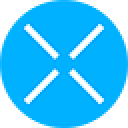-
 bitcoin
bitcoin $109667.069529 USD
-3.03% -
 ethereum
ethereum $3936.685804 USD
-4.07% -
 tether
tether $1.000493 USD
0.01% -
 xrp
xrp $2.771823 USD
-4.74% -
 bnb
bnb $957.805027 USD
-5.34% -
 solana
solana $196.735100 USD
-6.68% -
 usd-coin
usd-coin $0.999727 USD
-0.01% -
 dogecoin
dogecoin $0.227355 USD
-5.12% -
 tron
tron $0.335205 USD
-0.81% -
 cardano
cardano $0.779256 USD
-3.59% -
 ethena-usde
ethena-usde $0.999900 USD
-0.06% -
 hyperliquid
hyperliquid $42.492095 USD
-6.61% -
 chainlink
chainlink $20.501853 USD
-4.34% -
 avalanche
avalanche $28.952606 USD
-11.21% -
 stellar
stellar $0.356038 USD
-3.93%
How does DeFi lending work? What is the difference from traditional bank loans?
DeFi lending uses blockchain and smart contracts for decentralized, transparent loans, differing from traditional banks in accessibility, speed, and dynamic interest rates.
May 29, 2025 at 05:36 pm
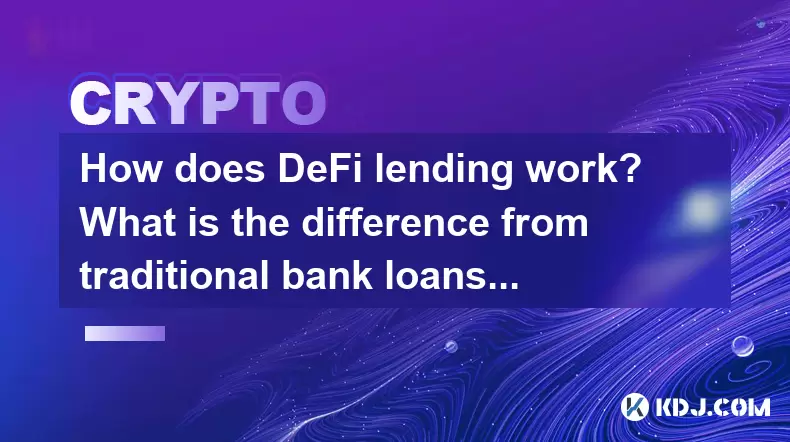
Introduction to DeFi Lending
DeFi lending, or decentralized finance lending, represents a revolutionary shift in the way borrowing and lending are conducted. Unlike traditional bank loans, DeFi lending operates on blockchain technology, offering a decentralized, transparent, and often more accessible approach to finance. This article will explore the mechanics of DeFi lending and highlight the key differences from traditional bank loans.
How DeFi Lending Works
DeFi lending leverages smart contracts on blockchain platforms, most notably Ethereum, to facilitate loans without the need for intermediaries like banks. Here’s how the process typically unfolds:
Depositing Collateral: Borrowers must deposit collateral, often in the form of cryptocurrencies like Ethereum or stablecoins. This collateral is locked in a smart contract.
Borrowing: Once the collateral is deposited, borrowers can take out loans in various cryptocurrencies. The amount they can borrow is determined by the value of their collateral and the platform's loan-to-value (LTV) ratio.
Interest Rates: Interest rates in DeFi lending are dynamic and can be influenced by supply and demand. Platforms like Aave and Compound use algorithms to adjust rates in real-time.
Repayment: Borrowers repay their loans with interest. If the value of the collateral drops below a certain threshold, the smart contract may automatically liquidate the collateral to cover the loan.
Withdrawal of Collateral: Upon full repayment, the collateral is released back to the borrower.
Key Differences from Traditional Bank Loans
DeFi lending differs significantly from traditional bank loans in several key areas:
Decentralization: DeFi lending platforms operate on decentralized networks, meaning they are not controlled by any single entity. Traditional banks, on the other hand, are centralized institutions.
Accessibility: DeFi lending is often more accessible. Anyone with an internet connection and some cryptocurrency can participate, whereas traditional banks may require credit checks, collateral, and other stringent criteria.
Transparency: Transactions on DeFi platforms are recorded on the blockchain, providing a high level of transparency. Traditional bank loans, by contrast, often involve opaque processes and hidden fees.
Interest Rates: DeFi platforms typically offer more competitive and dynamic interest rates. Traditional banks may have fixed rates that do not adjust to market conditions.
Speed: DeFi lending can be faster due to automation. Traditional bank loans may involve lengthy application and approval processes.
Risks and Considerations in DeFi Lending
While DeFi lending offers numerous advantages, it also comes with its own set of risks and considerations:
Volatility: The value of cryptocurrencies used as collateral can be highly volatile, leading to potential liquidation risks.
Smart Contract Risks: Errors or vulnerabilities in smart contracts can lead to security breaches or loss of funds.
Regulatory Uncertainty: The regulatory environment for DeFi is still evolving, which can pose risks for users.
Liquidity Risks: Some DeFi platforms may suffer from liquidity issues, making it difficult to withdraw funds quickly.
Popular DeFi Lending Platforms
Several platforms have emerged as leaders in the DeFi lending space, each with its unique features:
Aave: Known for its flash loans and variable interest rates, Aave allows users to lend and borrow a variety of cryptocurrencies.
Compound: This platform enables users to earn interest on their cryptocurrency holdings and borrow against them. Compound's interest rates are algorithmically adjusted.
MakerDAO: Users can generate DAI, a stablecoin, by locking up collateral in the Maker protocol. This platform is notable for its governance model and stability fees.
How to Participate in DeFi Lending
Participating in DeFi lending involves several steps, which can vary slightly depending on the platform. Here’s a general guide:
Choose a Platform: Research and select a DeFi lending platform that suits your needs, such as Aave, Compound, or MakerDAO.
Set Up a Wallet: You’ll need a cryptocurrency wallet compatible with the platform, such as MetaMask for Ethereum-based platforms.
Fund Your Wallet: Transfer the cryptocurrency you wish to use as collateral or lend to your wallet.
Connect to the Platform: Use your wallet to connect to the DeFi platform’s website or app.
Deposit Collateral: If you’re borrowing, deposit your chosen cryptocurrency as collateral into the platform.
Lend or Borrow: Decide whether you want to lend your cryptocurrency to earn interest or borrow against your collateral. Follow the platform’s instructions to complete the transaction.
Monitor and Manage: Keep an eye on your loans and collateral values. Be prepared to add more collateral or repay loans if necessary to avoid liquidation.
Frequently Asked Questions
Q: Can I use any cryptocurrency as collateral in DeFi lending?A: Not all platforms accept every type of cryptocurrency as collateral. Popular platforms like Aave and Compound typically support major cryptocurrencies like Ethereum and stablecoins. It’s important to check the specific requirements of each platform.
Q: How are interest rates determined in DeFi lending?A: Interest rates in DeFi lending are often determined by algorithms that adjust rates based on supply and demand. For instance, if there’s a high demand for borrowing a particular cryptocurrency, the interest rate for borrowing that asset may increase, while the rate for lending it may decrease.
Q: What happens if the value of my collateral drops significantly?A: If the value of your collateral falls below a certain threshold (known as the liquidation threshold), the smart contract may automatically liquidate your collateral to cover the loan. This is designed to protect lenders, but it can result in borrowers losing their collateral if they are unable to add more or repay the loan in time.
Q: Is DeFi lending regulated?A: The regulatory environment for DeFi lending is still evolving and varies by jurisdiction. Some countries have started to implement regulations, while others are still observing the space. It’s crucial for users to stay informed about the legal status of DeFi in their region.
Disclaimer:info@kdj.com
The information provided is not trading advice. kdj.com does not assume any responsibility for any investments made based on the information provided in this article. Cryptocurrencies are highly volatile and it is highly recommended that you invest with caution after thorough research!
If you believe that the content used on this website infringes your copyright, please contact us immediately (info@kdj.com) and we will delete it promptly.
- XRP Price, Cardano, and Layer Brett: Which Crypto Will Dominate?
- 2025-09-27 00:25:16
- Bitcoin ETF Bonanza: BlackRock, MicroStrategy, and the $86 Billion Revolution
- 2025-09-27 00:25:16
- Meme Coins, Trending Projects, and Your Portfolio: What's Hot Now?
- 2025-09-27 00:30:02
- mXRP Mania: How the XRP Yield Token and Supply Cap Sparked DeFi Frenzy
- 2025-09-27 00:30:02
- Crypto Market Watch: Bitcoin's Exhaustion Signals and the Meme Coin Revolution
- 2025-09-27 00:30:02
- Navigating the Economic Seas: Interest Rate Cuts, US Inflation, and the Fed's Tightrope Walk
- 2025-09-27 00:30:14
Related knowledge

How to track DeFi activity on a block explorer
Sep 04,2025 at 05:36pm
Bitcoin's Role in Decentralized Finance1. Bitcoin remains the cornerstone of the cryptocurrency ecosystem, serving as both a store of value and a benc...
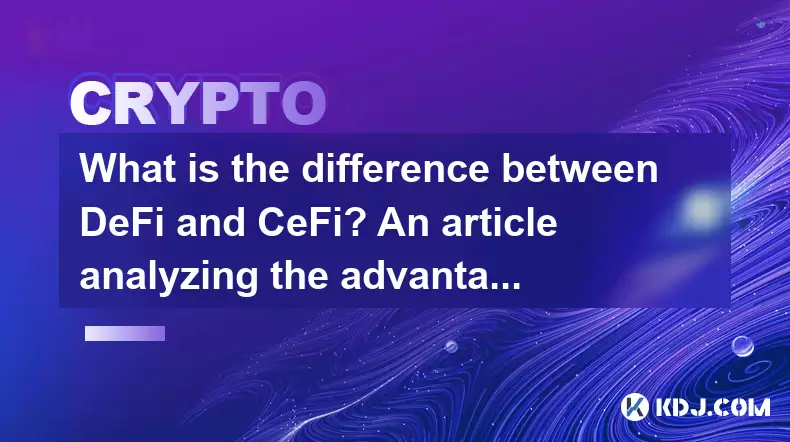
What is the difference between DeFi and CeFi? An article analyzing the advantages and disadvantages of both
Jun 13,2025 at 03:57am
Understanding the Foundations of DeFi and CeFiTo fully grasp the difference between DeFi (Decentralized Finance) and CeFi (Centralized Finance), it’s ...
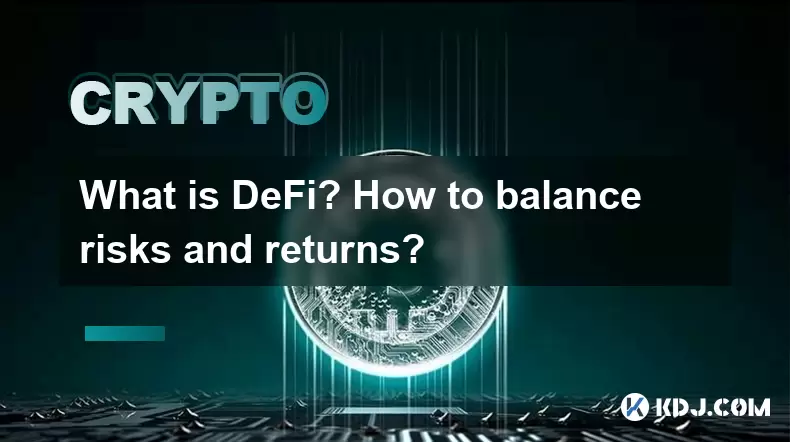
What is DeFi? How to balance risks and returns?
May 31,2025 at 12:22pm
What is DeFi? How to Balance Risks and Returns? Decentralized Finance, commonly known as DeFi, represents a revolutionary shift in the financial ecosy...

How does DeFi lending work? What is the difference from traditional bank loans?
May 29,2025 at 05:36pm
Introduction to DeFi LendingDeFi lending, or decentralized finance lending, represents a revolutionary shift in the way borrowing and lending are cond...
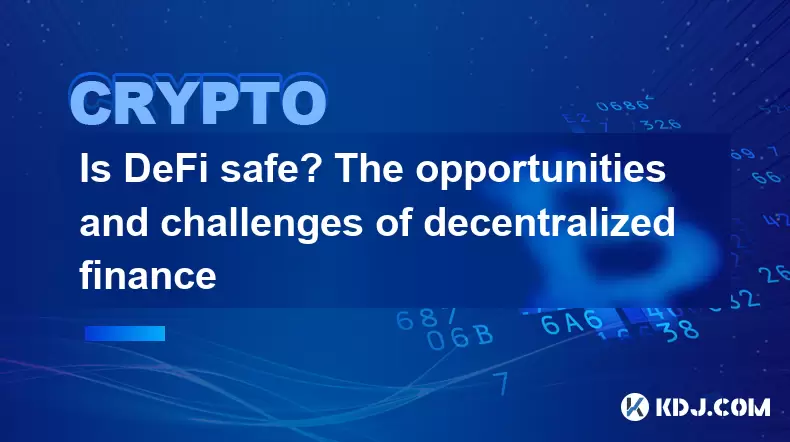
Is DeFi safe? The opportunities and challenges of decentralized finance
May 27,2025 at 02:28pm
Decentralized Finance, commonly known as DeFi, has revolutionized the financial landscape by offering a range of financial services without the need f...

DeFi Mining Tutorial: How to Maximize Profits and Reduce Risks?
May 27,2025 at 07:42am
DeFi, or Decentralized Finance, has opened up a new world of opportunities for crypto enthusiasts looking to maximize their profits through various mi...

How to track DeFi activity on a block explorer
Sep 04,2025 at 05:36pm
Bitcoin's Role in Decentralized Finance1. Bitcoin remains the cornerstone of the cryptocurrency ecosystem, serving as both a store of value and a benc...

What is the difference between DeFi and CeFi? An article analyzing the advantages and disadvantages of both
Jun 13,2025 at 03:57am
Understanding the Foundations of DeFi and CeFiTo fully grasp the difference between DeFi (Decentralized Finance) and CeFi (Centralized Finance), it’s ...

What is DeFi? How to balance risks and returns?
May 31,2025 at 12:22pm
What is DeFi? How to Balance Risks and Returns? Decentralized Finance, commonly known as DeFi, represents a revolutionary shift in the financial ecosy...

How does DeFi lending work? What is the difference from traditional bank loans?
May 29,2025 at 05:36pm
Introduction to DeFi LendingDeFi lending, or decentralized finance lending, represents a revolutionary shift in the way borrowing and lending are cond...

Is DeFi safe? The opportunities and challenges of decentralized finance
May 27,2025 at 02:28pm
Decentralized Finance, commonly known as DeFi, has revolutionized the financial landscape by offering a range of financial services without the need f...

DeFi Mining Tutorial: How to Maximize Profits and Reduce Risks?
May 27,2025 at 07:42am
DeFi, or Decentralized Finance, has opened up a new world of opportunities for crypto enthusiasts looking to maximize their profits through various mi...
See all articles




















